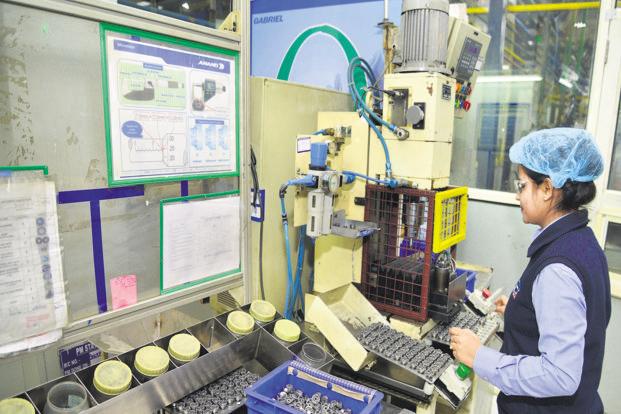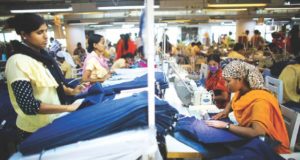By Devashish Mitra
Published in Livemint on March 13, 2018

Photo: Ramesh Pathania/Livemint
There is considerable evidence that restrictive labour regulations have prevented India from reaping the full potential benefits of opening up the economy
The Narendra Modi government’s recent doubling of duties on imports of beauty aids, watches, toys, furniture, footwear, and, surprisingly, kites and candles shows India’s lack of competitiveness even in these entry-level labour-intensive industries. Also, a similar recent doubling of import duties on electronics, including related inputs and parts, is an admission by the government of the country’s lack of competence in the highly labour-intensive, low-skilled and repetitive tasks of processing or assembling duty-exempt imported inputs to produce and export finished mobile phones and TVs. And, in textiles and apparel exports, India is now being outperformed not only by China but also by Bangladesh and Vietnam.
To anyone who is aware of the panoply of India’s restrictive labour regulations (about 200 labour laws, with over a fourth being central acts), it does not come as a surprise that India is unable to grasp its natural comparative advantage in labour-intensive products. Indeed, Indian producers find it cost-effective to use relatively capital-intensive production techniques and often produce fairly capital-intensive products, as shown by my research with Rana Hasan (Asian Development Bank) and Asha Sundaram (University of Auckland).
The Industrial Disputes Act (IDA) requires firms with 100 or more workers to seek government permission to retrench or lay off any worker. This permission is rarely granted. The Industrial Employment (Standing Orders) Act, 1946 requires employers in firms with 100 or more workers (50 or more in certain states) to seek permission even for reassigning a worker from one task to another. And the Trade Unions Act allows any seven employees to form a union, thereby using up a large proportion of the firm’s managerial resources in dealing with several unions within itself. Through this regulation, unions have the right to strike and represent workers in legal disputes with employers. Last but not the least, the The Contract Labour (Regulation And Abolition) Act, 1970 restricts, and even prohibits, the use of contract workers for certain tasks. Thus, these labour regulations effectively prevent firms from using labour-intensive methods of production. Also, since these laws hold above certain threshold employment levels, firms often have an incentive to remain small and “informal”.
Exploiting cross-state variations, based on state-level amendments to central labour acts (allowed by the Constitution) and the varying degrees of their implementation, Tim Besley and Robin Burgess at the London School of Economics have found that state-level manufacturing output and employment go down in the formal sector but go up in the informal sector, as we move from less to more restrictive regulatory schemes. Thus, when labour laws squeeze the relatively productive formal sector, there is a spillover of their output and employment into the low-productivity informal sector.
Another research finding, by Poonam Gupta, Rana Hasan and Utsav Kumar, that output and employment growth in labour-intensive industries is slower in states with relatively restrictive labour regulations as compared to other states. Furthermore, Rana Hasan and Karl Jandoc find that a large majority of labour-intensive manufacturing employment in the restrictive-regulation states (about 60%) is concentrated in small firms employing less than 10 workers, while this proportion is considerably lower (at 40%) in the case of the latter states, with relatively flexible labour markets. These proportions for large firms employing over 200 workers are 10% and 25%, respectively, for the rigid-regulation states and others. Not surprisingly, therefore, productivity of labour-intensive manufacturing firms is much higher (11-14%) in flexible labour market states, as seen from research by Sean Dougherty, Verónica C. Frisancho Robles and Kala Krishna.
There is also considerable evidence that restrictive labour regulations have prevented India from reaping the full potential benefits, including in output, productivity and employment, from opening the economy. A recent study by Rahul Ahluwalia, Rana Hasan, Mudit Kapoor and Arvind Panagariya shows this in the case of wage and employment gains in India’s apparel and textile firms, arising from developed countries lifting their quotas on the imports of clothing. The adverse impact of India’s labour regulations on benefits from international trade is not surprising since these gains are generated through reallocation of resources across firms and industries, which restrictive labour regulations can impede and distort.
Clearly, the main policy implication of this discussion is the urgency of labour reforms. Small steps, especially at the state level, have been taken recently. The IDA threshold has been raised from 100 to 300 workers in Andhra Pradesh, Haryana, Madhya Pradesh, Maharashtra, Rajasthan and Uttarakhand. Rajasthan has also raised the membership threshold of a union to 30% of a firm’s employment. At the central level, a unified web portal for the self-reporting of compliance with 16 central acts has been set up. Inspections take place only when triggered by a built-in algorithm within the portal, reducing possible harassment by inspectors.
Further reforms should include, as suggested by Jagdish Bhagwati and Arvind Panagariya, the exclusion of non-confirmation of a worker on probation and downsizing in response to changes in demand and technology from IDA’s definition of retrenchment. Also, more flexibility in task reassignment should be allowed within the Industrial Employment (Standing Orders) Act. Besides, no more than a single union should be allowed within any firm. And, finally, more labour laws should be covered within the newly installed self-reporting web portal. All of these changes will provide Indian producers more flexibility in responding to shocks and make them more competitive.
Devashish Mitra is professor of economics and Cramer professor of global affairs at the Maxwell School of Citizenship and Public Affairs, Syracuse University, New York.
 CPD RMG Study Stitching a better future for Bangladesh
CPD RMG Study Stitching a better future for Bangladesh



